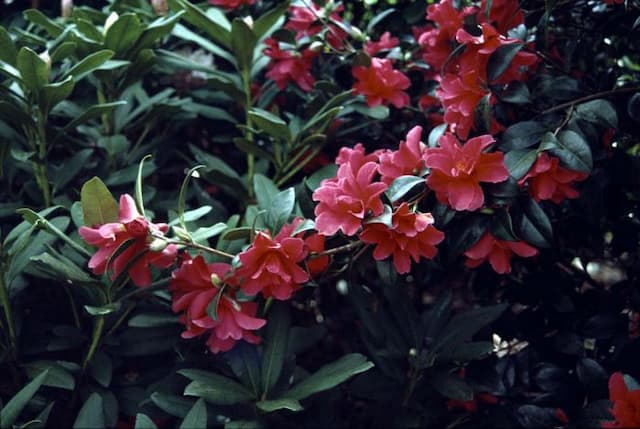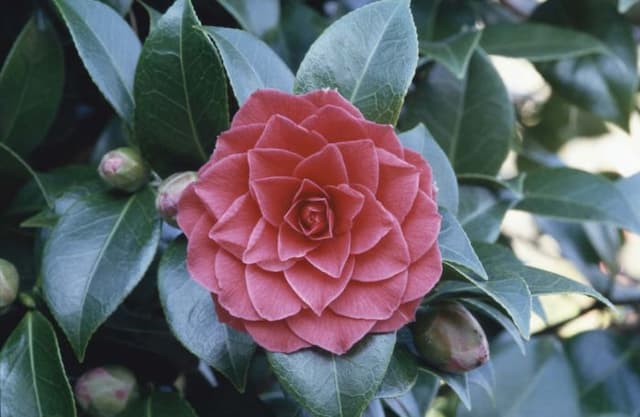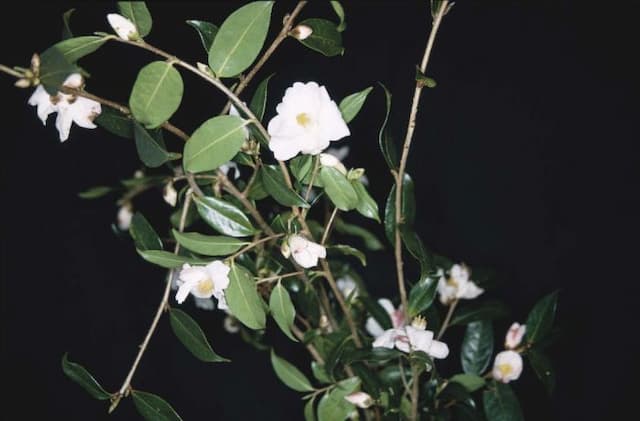Japanese Camellia Camellia japonica 'Ave Maria'

ABOUT
The Camellia japonica 'Ave Maria' is known for its stunning blooms which are the centerpiece of its visual appeal. The flowers are typically large and resemble a peony in shape, boasting an array of perfectly arranged petals. These petals range in color from a delicate pink to a more rich and intense shade, sometimes with a gradient of hues that blend seamlessly together. The blooms sit proudly against the plant's lush backdrop of glossy, dark green leaves that have a leathery texture. The leaves are oval-shaped with a pointed tip and create a dense, evergreen canvas that contrasts beautifully with the softness of the flowers. This variety of camellia tends to produce its showstopping flowers during the cooler months, bringing a splash of color to gardens when many other plants have ceased to bloom. The overall appearance of Camellia japonica 'Ave Maria' is one of elegance and classic beauty, making it a cherished addition to many garden settings.
About this plant
 Names
NamesFamily
Theaceae
Synonyms
Japanese Camellia, Rose Of Winter, Tsubaki
Common names
Camellia japonica 'Ave Maria'.
 Toxicity
ToxicityTo humans
The Camellia is generally considered non-toxic to humans. There are no widely recognized symptoms of poisoning from ingesting parts of this plant. As with any plant material, consumption is not advisable and may cause mild stomach upset in certain individuals, but significant toxicity is not expected.
To pets
The Camellia is also generally considered non-toxic to pets, including cats and dogs. Ingesting parts of this plant should not result in significant symptoms of poisoning. However, ingestion of plant material could potentially lead to gastrointestinal upset or irritation in some pets, but serious toxicity is typically not a concern.
 Characteristics
CharacteristicsLife cycle
Perennials
Foliage type
Evergreen
Color of leaves
Green
Flower color
Pink
Height
6-12 feet (1.8-3.7 meters)
Spread
6-10 feet (1.8-3 meters)
Plant type
Shrub
Hardiness zones
7-9
Native area
Japan
Benefits
 General Benefits
General Benefits- Ornamental Value: The Camellia japonica 'Ave Maria' has large, beautiful flowers that add visual interest to gardens and landscapes.
- Year-Round Foliage: It is an evergreen shrub, providing green foliage throughout the year.
- Drought Tolerance: Once established, it has a moderate tolerance to drought, reducing the need for frequent watering.
- Shade Tolerance: It can grow well in partial shade, making it suitable for understory planting or north-facing gardens.
- Long Blooming Period: It typically has a lengthy flowering season, often from late winter to early spring.
- Wildlife Attraction: The flowers can attract pollinators such as bees, aiding in the local ecosystem's biodiversity.
- Privacy Screen: With its dense growth habit, it can be used as a privacy screen or hedge in landscape designs.
- Variety of Uses: It can be utilized in various garden styles, including formal, cottage, and woodland gardens.
- Low Maintenance: It requires relatively low maintenance once established, with minimal pruning and care.
- Cultural Significance: Camellias have cultural importance in East Asia and can be used to add an Asian aesthetic to gardens.
- Soil Adaptability: It is adaptable to a range of soil types, provided they are well-draining and rich in organic matter.
 Medical Properties
Medical PropertiesThis plant is not used for medical purposes.
 Air-purifying Qualities
Air-purifying QualitiesThis plant is not specifically known for air purifying qualities.
 Other Uses
Other Uses- Camellia japonica leaves can be used to polish wood floors or furniture, as they contain oils that give a natural sheen and protect the wood.
- The petals of the Camellia japonica can be crystallized and used as edible decorations for cakes and desserts.
- Leaves from the Camellia japonica can be used in aquariums to provide tannins, which can help replicate the natural water conditions for certain tropical fish.
- The flowers can be used as natural dye sources for fabrics or paper, yielding gentle hues of pink or red depending on the processing method.
- Camellia japonica's sturdy branches can be fashioned into small tools or handles for brushes, owing to the wood's fine grain and strength.
- Floral artists can use Camellia japonica blooms for creating living jewelry, such as earrings or necklaces, due to their beauty and size.
- Petals of Camellia japonica can be infused in oils to create fragrant concoctions for use in aroma diffusers or homemade perfumes.
- Dried and pressed Camellia japonica flowers can be used in scrapbooking or papermaking to add natural elements to the craft.
- The blooms of Camellia japonica can serve as natural indicators for pH balance in a garden, as certain flower colors can signify the pH level of the soil.
- Camellia japonica leaves can be used as organic lining material for serving baskets or trays, providing decoration and a fresh scent.
Interesting Facts
 Feng Shui
Feng ShuiThe Camellia is not used in Feng Shui practice.
 Zodiac Sign Compitability
Zodiac Sign CompitabilityThe Camellia is not used in astrology practice.
 Plant Symbolism
Plant Symbolism- Adoration and Devotion: The Camellia japonica 'Ave Maria' as a species symbolizes adoration and deep devotion, reflecting the heartfelt and enduring qualities of the flower.
- Perfection and Excellence: Reflecting its flawlessly formed petals and elegant appearance, the Camellia represents the pursuit of perfection and excellence.
- Long-lasting Love: With its long blooming season and evergreen nature, this flower also symbolizes enduring and long-lasting love.
- Beauty: The sheer beauty of the Camellia japonica 'Ave Maria' makes it a symbol of physical and inner beauty.
- Refinement: Often associated with cultivated elegance, the Camellia symbolizes refinement and sophistication.
- Faithfulness: Given its long-lasting nature, the flower also signifies faithfulness and the ability to stand strong over time.
 Water
WaterThe Japanese Camellia 'Ave Maria' prefers consistently moist soil and should be watered with 1 to 1.5 gallons of water weekly. During the growing season in spring and summer, water the plant thoroughly when the top inch of soil feels dry to the touch, avoiding excess moisture that can lead to root rot. In the fall and winter, reduce watering to every other week or less, just enough to prevent the soil from drying out completely. If the Camellia is planted outdoors, natural rainfall may decrease the need for supplemental watering, but ensure it receives adequate moisture during dry spells.
 Light
LightJapanese Camellia 'Ave Maria' thrives in partial shade to light, dappled sunlight. It is best to position the plant where it will be protected from the intense afternoon sun, such as an east-facing spot that gets morning light and afternoon shade. Too much direct sunlight can scorch the leaves, while too little light can reduce flowering.
 Temperature
TemperatureJapanese Camellia 'Ave Maria' prefers a temperature range between 60 to 70 degrees Fahrenheit during the day and not below 50 degrees Fahrenheit at night. This plant can withstand minimum temperatures of around 20 degrees Fahrenheit, but prolonged exposure to cold below this can damage the plant. Camellias generally perform best in mild climates without extreme heat or frost.
 Pruning
PruningPrune Japanese Camellia 'Ave Maria' to remove any dead or damaged wood and to shape the plant, ideally right after the blooms have faded in late winter or early spring. This timing prevents cutting off next season's buds, which form in summer. Pruning is also an opportunity to open up the plant to increase air circulation, which can reduce the risk of diseases.
 Cleaning
CleaningAs needed
 Soil
SoilCamellia japonica, commonly known as the Japanese Camellia, thrives in acidic soil with a pH between 5.5 to 6.5. The best soil mix for this plant consists of equal parts quality camellia or azalea potting mix, peat moss, and pine bark to enhance aeration and drainage.
 Repotting
RepottingJapanese Camellias should generally be repotted every two to three years, in spring after flowering or in autumn. It is important to use an acid-based potting mix when repotting these plants.
 Humidity & Misting
Humidity & MistingJapanese Camellias prefer a high humidity level, ideally between 50-60%. These plants will benefit from a humid environment but should also have good air circulation to prevent disease.
 Suitable locations
Suitable locationsIndoor
Place in bright, indirect light and ensure high humidity.
Outdoor
Plant in partial shade, protect from strong winds.
Hardiness zone
7-9 USDA
 Life cycle
Life cycleCamellia japonica 'Ave Maria', commonly known as the Japanese camellia, starts from a seed which germinates in well-drained soil with some shade. The seedling then develops into a young plant with a set of true leaves and begins the vegetative growth stage, increasing in size and producing more complex leaf structures. As the plant matures, it enters the flowering phase, typically during late winter to spring, showcasing large, ornate pink blossoms. After pollination, which is often facilitated by insects, the fertilized flowers produce seed pods that eventually mature and release seeds to begin a new generation. Throughout its lifespan, the Japanese camellia will undergo periods of active growth and dormancy, aligning with seasonal changes in temperature and daylight. With proper care, including adequate watering, pruning, and protection from extreme conditions, the Japanese camellia can live for many decades, sometimes even over a century.
 Propogation
PropogationPropogation time
Spring-Early Summer
Camellia japonica 'Ave Maria', commonly known as the Camellia, is most frequently propagated through semi-hardwood cuttings. This method is typically done during the late summer after the blooms have faded and the new growth has begun to mature and harden slightly. A healthy branch is selected and a cutting of about 4 to 6 inches (10 to 15 centimeters) is taken, ensuring there are at least two to three sets of leaves. The lower leaves are removed, and the base of the cutting is dipped in rooting hormone to encourage root development. The prepared cutting is then placed in a well-draining potting medium kept moist, and under high humidity. A plastic cover or a propagation dome can be used to maintain the necessary humidity levels. Cuttings usually root within six to eight weeks, after which they can be gradually acclimatized to less humid conditions and eventually transplanted.









